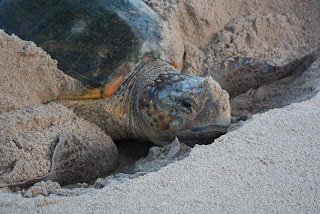What an amazing experience to spend some one on one time with one of these gently giants of the sea. Here at Mamoli we are lucky enough to have one of the main nesting beaches for turtles in the whole of Mozambique.
Our most regular sightings are loggerhead and leather back turtles, and on this occasion I was in the right time at the right place :)
Pure Magic... me and the loggerhead on a lazy Sunday...
SOME TURTLE FACTS:
The Leather back is the largest of all the sea turtles and can grow up to 1.2 to 2.4 meters in length. They weigh between 225 and 900 kg. The average adult measures in between 1.5 and 1.8 meters and weigh 270 to 360 kg.
It is the oldest of all turtle species and has been around for about 150 million years. They have survived the mass extinction of the dinosaurs and has thrived until the last several decades when human interaction have taken a major toll on their population, now being considered a critically endangered species.
Leather backs can consume twice their own body weight in prey per day, feeding exclusively on soft-bodied invertebrates like jellyfish. Their smooth leathery skin (this is the only turtle species without a hard shell) covering a flexible matrix of bone. This specialised, flexible carapace allows them to dive to great depths unlike other sea turtles. In fact they can dive deeper than 1200m! Sperm Whales, Beaked Whales and Elephant Seals are the only other known animals on the planet that dive deeper.
They can tolerate very cold waters due to thermoregulatory adaptions which allow them to maintain their core body temperature.
The eggs will take about 60 days to hatch, during which time they need to be kept warm, about 29 degrees C. At this temperature 50% will be male and 50% will be female. The eggs a the bottom of the nest are more insulated but may be a little bit cooler. The eggs on top may have less insulation and will be open to more temperature changes. Generally eggs that develop at a cooler temperature than 29 Degrees C will be male turtles and those that develop at a higher temperature than 29 Degrees C will be female turtles.
The Loggerhead (Caretta Caretta), is names as such for it's exceptionally large head.
They have heavy strong jaws and their Carapace is bony without ridges and have rough scutes (scales) present with 5 latiral scute. The Carapace is heart shaped.
Their front flippers are short and thick with two claws, while the rear flippers can have two or three claws. Their bodies are reddish-brown in colour whilst their bellies has a pale yellowish hue. They can typically grow between 0.8 to 1.1 metres in length and an adults will weigh between 70 and 170kg.
They are primarily carnivorous and feed mostly on shellfish that live on the bottom of the ocean. Some of their favourite food includes horse shoe crabs, clams, mussels and other invertebrates. Their powerful jaw muscles help them crush the shellfish.
They prefer to feed in coastal bays as well as in shallow water along the continental shelf of the Atlantic, Pacific and Indian Oceans.
Mom's nest at intervals of 2 to 4 years. They can lay 3 to 6 nests per season, approximately 12 to 14 days apart. Each nest can contain up to 100 - 126 eggs and the eggs incubate after 60 days.
They are listed at threatened and can very easily become endangered and even extinct in the foreseeable future. Their greatest threat is loss of nesting habitat due to coastal development, predation of nets and human disturbances. Coastal lighting cause disorientation of the hatch lings during their emergency from the nest as they follow the moon back to the water and safety.
If lights are in the area, hatch ling will often follow the light instead of the moon in the wrong direction....
Other problem we face here at mamoli is the crabs, who attack the small hatch lings on their way to the water.
 |
| Very calm, laying her eggs! Not worried about an onlooker at all! |
Returning home after a hard days work, digging holes, laying eggs.










No comments:
Post a Comment